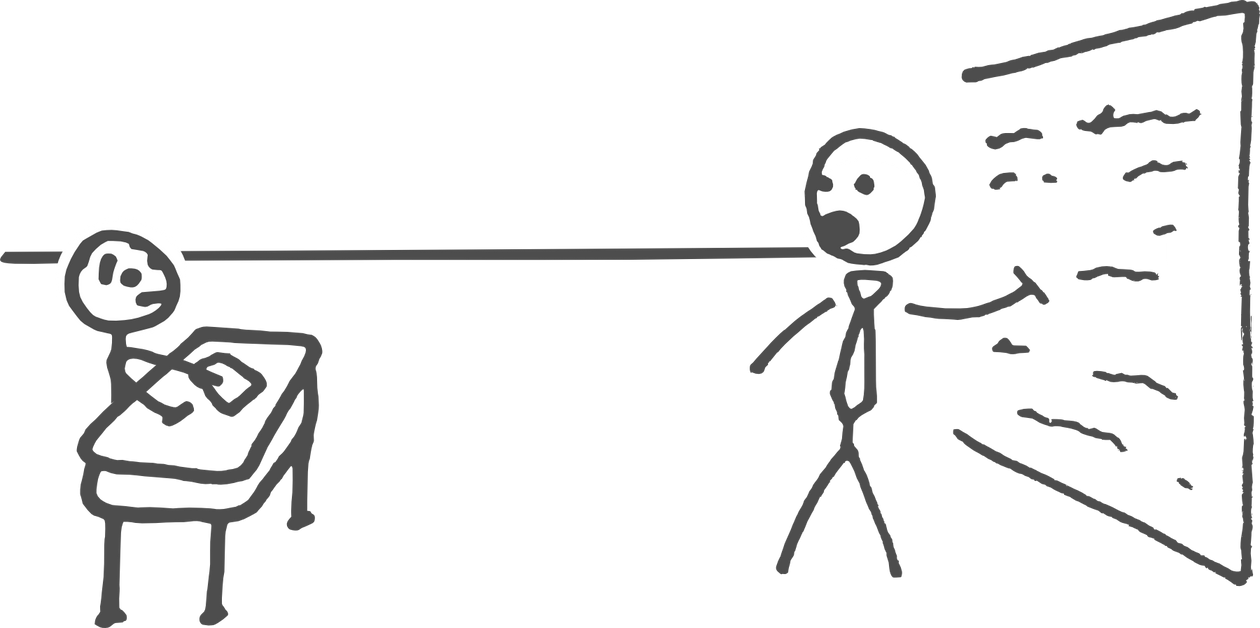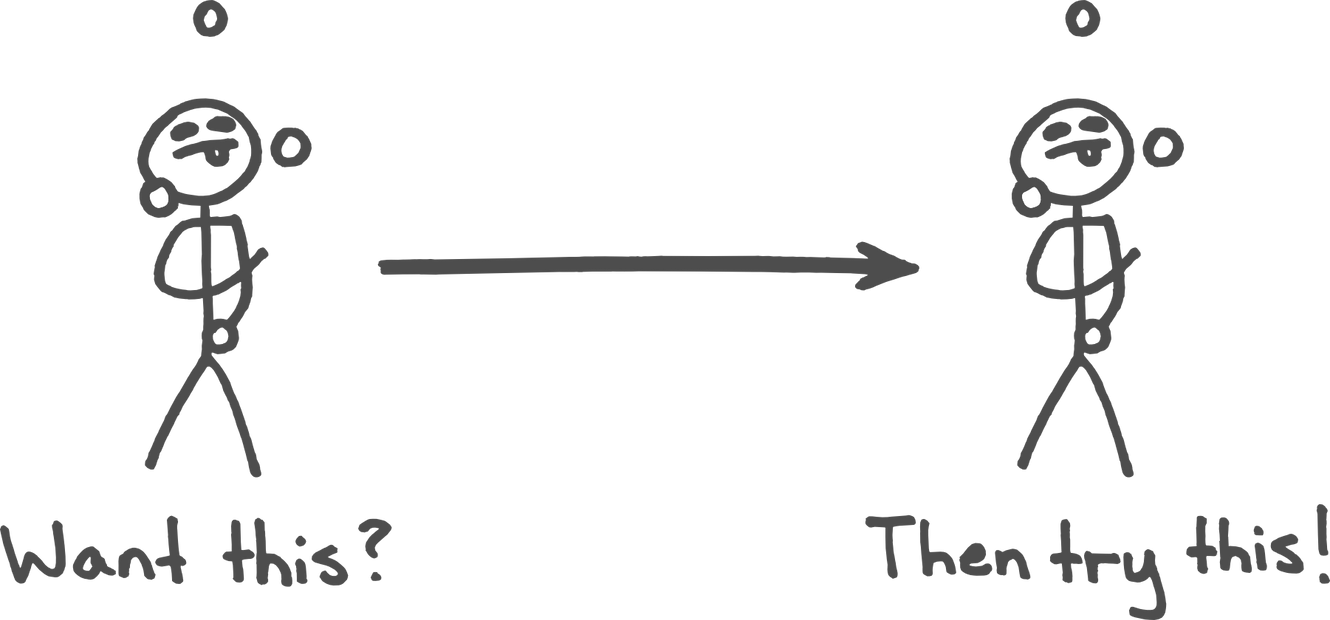...uplinks, including horizontal links to competitors or antipatterns
Practice makes permanent, not perfect. Training results in competence at the trained behavior, not the intended behavior.

Consider the following anecdotes:
- A student in a mathematics class pays close attention as the teacher lectures, following each example problem and taking detailed notes, only to return home and discover that they aren’t able to make any headway at all on the homework problems.
- A police officer disarms a hostile suspect in a tense situation, and then reflexively hands the weapon back to the suspect.
- The WWII-era Soviet military trains dogs to seek out tanks and then straps bombs to them, intending to use the dogs to destroy German forces in the field, only to find that they consistently run toward Soviet tanks instead.
- A French language student with three semesters of study and a high GPA overhears a native speaker in a supermarket and attempts to strike up a conversation, only to discover that they are unable to generate even simple novel sentences without pausing noticeably to think.
...this list could go on and on. There are endless examples in our common cultural narrative of reinforcement-learning-gone-wrong; just think of the pianist who can only play scales, the neural net that was intended to identify images of tanks but instead only distinguished cloudy days from sunny ones, or the fourth grader who reflexively says “I love you” to his classmate over the phone before hanging up in embarrassed silence.
There is a common pattern to these and many other failures, and recognizing it can both prevent you from ingraining the wrong habits and “turbocharge” your efforts to train the right ones.
At its core, the turbocharging model is simple. It begins with a single claim: people tend to get better at the things they practice, and (usually) not at the things they don’t. More formally: behavior tends to be self-reinforcing—each repetition of a behavior makes another future repetition of that same behavior more likely.
What this means in practice is that (according to the model) intent has little or nothing to do with results. In the anecdotes above:
- The police officer practiced disarming opponents, intending to develop a useful defensive skill. Unfortunately, the officer also “practiced” handing the weapon back to their partner after every round, and so the handing-back became every bit as reflexive as the disarming motion.
- The Soviet dogs were effectively trained to seek out and crawl under tanks, but since all of the tanks that were available for training were Soviet and diesel-fueled, the dogs (who relied heavily on their sense of smell) preferred those to the unfamiliar gasoline-fueled German tanks, not realizing that they were intended to seek out Germans.
- The French language student intended to build conversational fluency by conjugating verbs, practicing set phrases, and translating English sentences, but the actual skill of generating novel speech was never emphasized and therefore never honed.
In each of these cases, the people involved did indeed gain proficiency with the specific skill they had actually practiced, but that skill was not quite the one they wanted.
There are caveats to this principle (more on them below), but taken as a given, it provides a powerful tool both for evaluating a given training scheme and for generating training schemes that will actually work. The world is full of things that are “supposed to” teach us some skill or another, despite the fact that many of them bear no close resemblance to the desired final competency.
Previous participants armed with this principle correctly predicted a number of ways in which traditionally trained aikido students might react given an actual unexpected attack (flinching, reflexively stepping back after blocking, defaulting to defenses other than the intended/ideal one because of the absence of the customary “trigger”); when given the failure mode described above for the French language student, they rapidly generated the concept of immersive learning from scratch.
The key is to attend to detail on the movement-by-movement or thought-by-thought level. Returning to our hypothetical math student—it’s not sufficient to ask ourselves whether they’re “listening to the instructor” or “thinking through the example.” Instead, we must ask unambiguous questions like:
- Is the student looking at the board and actively thinking about the symbols they’re seeing?
- Is the student calling up related material from memory (e.g. the quadratic equation, the Euler method, the decimal expression of the square root of two)?
- Is the student generating hypotheses as to the likely next step?
- Is the student thinking about the underlying structure of the problem in a way that is not dependent on the specific numbers or framing given in the example?
- Is the student waiting for the instructor to provide all of the relevant information, and only confirming their own understanding after the fact (hindsight bias)?
...only with that level of detail can we understand what specific skills are actually being rehearsed (and thus ingrained and reinforced), and then make judgments of—and improvements to—a given training scheme. The Turbocharging algorithm is:
1. Select a skill you want to acquire or improve.
2. Select a practice method (either a preexisting one you wish to evaluate, or a preliminary one you wish to strengthen).
3. Evaluate the resemblance between the method and the desired skill.
4. To the extent that the answers from (3) are cause for concern, adjust your practice method (or choose a new practice method altogether).
If you are training parkour and you would like to get good at climbing walls, then climb lots of different walls—don’t do squats or lift weights or train on trampolines. If you are halfway through and you discover that you need more raw strength, then you might do squats or lift weights, but you’ll be doing so in order to build strength, not “because” doing squats or lifting weights will make you better at the skill of climbing walls.
Similarly, if you are learning to code and you would like to get good at creating algorithmic solutions to problems, then find lots of different practice problems that have algorithmic solutions. If, instead, you want to build websites, then build websites. Always be wary of advice that you should do activity A “because it will make you good at activity B.” Sometimes this is actually true, but more often than not, it’s wasted motion.
Therefore:
Make your practice as close to the real situation as you can.

downlinks